
If you think “want to go to a tea party! “, this is the page you should definitely read. We’re Introducing what to bring, what to wear, and the minimum rules and manners you should know before tea ceremonies.
To whom interested in Japanese traditional culture and want to go to a tea party,
I thought you were wonderful♪
Here, we would like to introduce what you need to know before participating in the ``大寄せ【OOYOSE(Many persons )】Tea Ceremony”, which is often attended by beginners.
Knowing about them and become a welcomed customer by your teachers and seniors♪
CONTENTS: 1.About clothing:Western style/Long skirt or Pants are recommended. White socks are welcome.Kimono/White 半襟【HAN-ERI(attached color)】and white 足袋【TABI(Japanese traditional socks)】. 2About belongings for tea ceremony:懐紙【KAISHI】黒文字【KUROMOJI】are necessary at least.And other tools convenient to bring. 3.About manners:No accessories(especially for rings and long neckless).Don't step on the edge of the TATAMI mat. Don't step into 道具畳【DOUGU-TATAMI】mat(The place where 点前【TEMAE】is held.Don't lift tools up high when looking at them.
1.About 茶会【TEA CEREMONY】clothing :●Western style/Long skirt or Pants are recommended. White socks are welcome.●Kimono/White 半襟【HAN-ERI(attached color)】and white 足袋【TABI(Japanese traditional socks)】.
●If you were wearing in western style…
When it comes to clothes, since you sit up in 正座【SEIZA】 straight, so long, fluffy skirts that cover your legs or loose-fitting pants are convenient.
As a matter of etiquette, avoid entering the tea room with bare feet or stockings, and be sure to wear white socks. It is said that the tea room is a clean place.
It’s best to avoid wearing anything too casual, such as jeans and sandals if it was a formal tea ceremony.
As you sit up straight in jeans,
your legs get numb too💦
●If you were wearing 着物【KIMONO】・・・
When it comes to KIMONO for tea ceremony, basic kinds are made of traditional high quality silk called 正絹【SHOUKEN】.

色留袖【IRO-TOMESODE】,付け下げ【TSUKESAGE】/訪問着【HOUMON-GI】,小紋【KOMON】, 色無地【IRO-MUJI】with 一つ紋【HITOTSU-MON(one family crest)】 might be the best. White 半襟【HAN-ERI】and white 足袋【TABI】are required.

If you were not married and the tea ceremony was in 初釜【HATSU-GAMA(The first tea ceremony in a year)】or very formal and auspicious one, 振袖【FURI-SODE】might be welcomed.
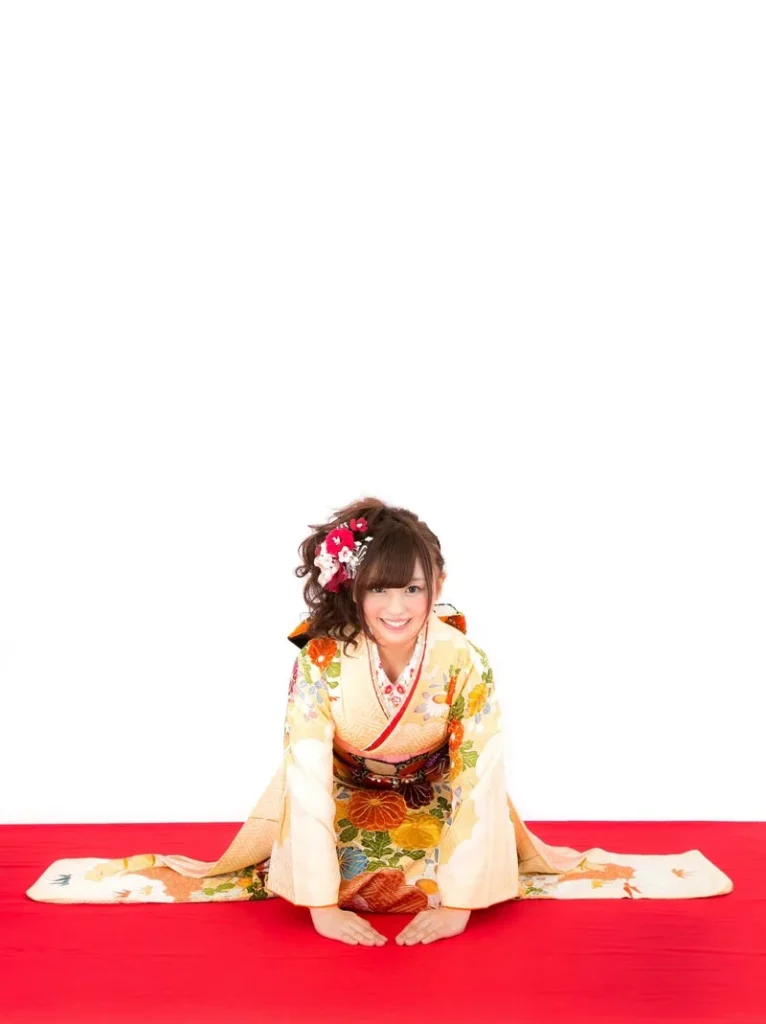

帯【OBI】is tied in お太鼓【O-TAIKO(Japanese drum shape)】style is basic.
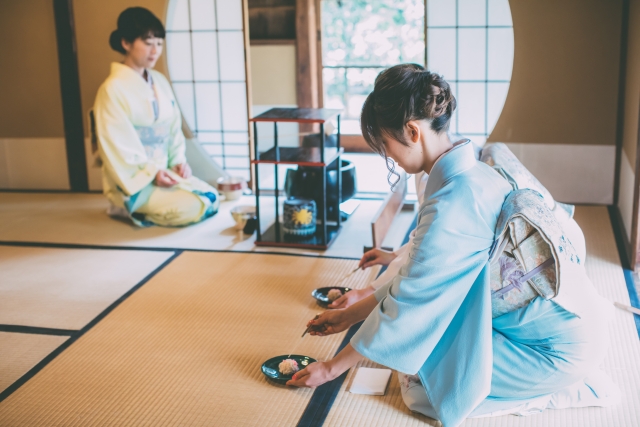
(紬【TSUMUGI】shoud be avoided even though it is made of silk and popular, because it seemed casual.)
MORE DETAILS ABOUT KINDS OF 着物【KIMONO】▶
1. 着物【KIMONO】;Fundamental knowledges about Japanese beautiful traditional wear!There are about 8 kinds and it is different depend on where, who, objects so on.
Recently, there are Casual 浴衣【YUKATA】Tea Ceremony in summer. Please check the dress code in advance. Even in that case, it is best to avoid going barefoot and bring white 足袋【TABI】socks.
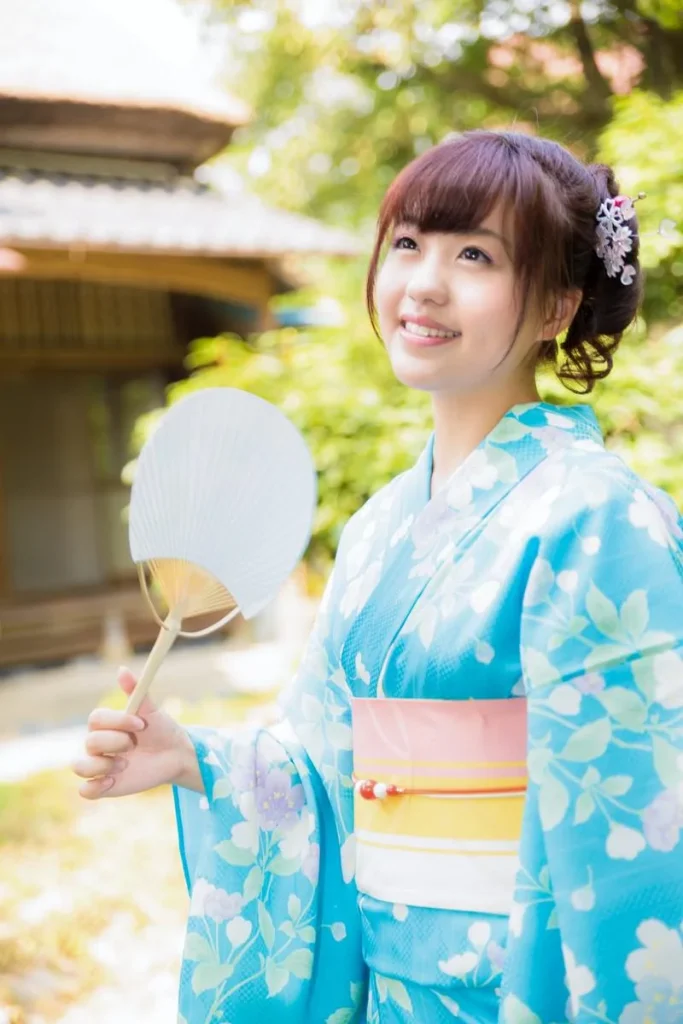

▶How different 着物【KIMONO】and 浴衣【YUKATA】?
: 浴衣【YUKATA】is the most casual type of 着物【KIMONO】in summer. It’s easy to wear and need less items than formal kimonos, so it’s very popular among young people to go out in summ
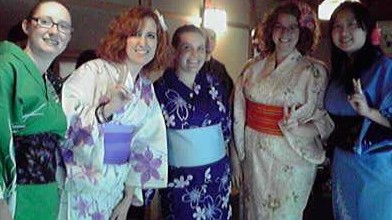
In summer, it would be also nice to wear 夏着物【NATSU-KIMONO( Summer Kimono)】. They are made of silk 正絹【SHOUKEN(High quality silk)】 or 麻【ASA(Linen)】and are woven in a weaving methods called 絽【RO】or 紗【SHA】, which has open slight spaces between textures and giving a cool appearance for eyes. There are also 帯【OBI】, 襦袢【JYUBAN】, 半襟【HAN-ERI】, 帯締め【OBI-JIME】, 帯揚げ【OBI-AGE】used only in mid summer.
They are only be worn in mid summer, so can be considered a luxurious kimono. Nevertheless, if you wear a summer kimono while wearing a parasol in the middle of summer, you will be able to stand out from others.
ESSAY2:About how to wear kimono that are not allowed in formal tea rooms.
The formal tea room is a clean place, so 白半襟【SHIRO-HANERI(White half-collars)】 and 白足袋【SHIRO-TABI(White TABI socks)】 are recommended.
Colored and patterned Half collars and TSBI socks are fun to coordinate and are very cute, but they may be best avoided at formal tea parties. However, there may be casual tea parties held in these days, so check with the host in advance to confirm the atmosphere.
ESSAY3. It is said that casual, “everyday kimonos” such as 紬【TSUMUGI】are not appropriate for formal tea parties, no matter how expensive they are.
紬【TSUMUGI】is a kimono made from silk thread extracted from waste cocoons that is first dyed and then woven. No matter how expensive it is, it is considered everyday wear and is not suitable for a tea ceremony.
2.About belongings for tea ceremony:懐紙【KAISHI】黒文字【KUROMOJI】are necessary at least.And other tools convenient to bring.
At first, check basic 2 items out !
●懐紙【KAISHI】・・・Rectangle Japanese traditional papers for putting on 和菓子【WA-GASHI(Japanese Sweets)】.


Usually, 30 pieces are in one-set.Size for women and men are different(For women: about 14.5×17.5 cm, For men:17.5×20.6 cm). Some of them have beautiful patterns or pretty see-through patterns.

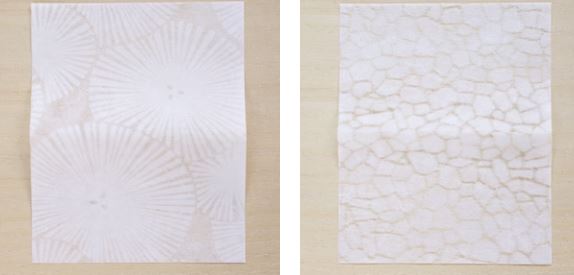
HOW TO USE IT:
Bring them in a small bag for tea tools and prepare some of them into your Kimono’s chest part which is crossing your colors are.

Take one piece of them and put it in front of you. Fold the paper like it ( the way how to hold is different depend on school, so please follow the way you learned).※This picture is 石州流【SEKISYUU-RYUU】Way.
Take one 和菓子【WAGSHI】Sweet from a large plate and put it on your 懐紙【KAISHI】paper. You use it like a small dish for a sweet.
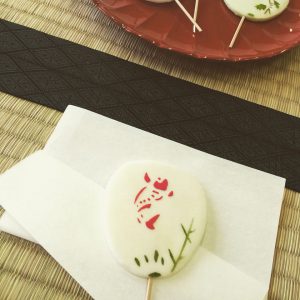
Please take it back to your home by yourself ( You can put it into your sleeve if you were wearing kimono, or put it into your bag.)
●黒文字【KURO-MOJI】・・・Wooden picks for cutting and eating 和生菓子【WANAMA-GASHI(JJapanese Raw Sweet)】. It is made from the plant named 黒文字【KURO-MOJI】.
You use it like this: Cut Wanama- Sweet into one- bite size.


You can wash it and use it several times. So, please put it in your bag and take it them back.
There are also beautiful, metal picks having some designs like crane or too.
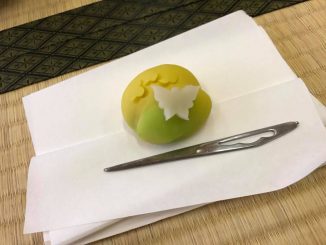
Some of them are in cloth cases.

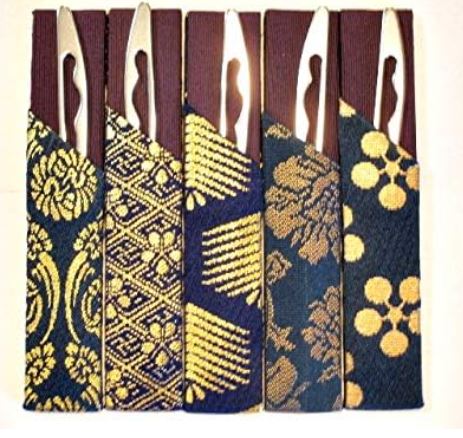
お茶会に参加するときは、懐紙と黒文字は最低限持っていききましょう。
お茶をやっている方に誘われた場合は、その方が用意して下さるかもしれません。また、最近はお席の側で人数分の準備をしてくれていることも多いようです。
About other things that are useful to have
●TABI-Cover ・・・Tabi covers are used to protect white tabi from getting dirty when walking outside.
●風呂敷・・・荷物をひとまとめして茶室の外に置いておくのに便利です。
慣れてきたら欲しい!その他の持ち物
●袱紗(ふくさ)・・・自分でお点前をするようになったら、必須のアイテムです。お道具を清めたり、熱い釜の蓋を取るのに折りたたんで使ったり大活躍!
お茶のお稽古では、まずこの袱紗の扱い方から習うことがほとんど。
女性は朱色、男性は少し大きめで紫色が一般的です。
白扇(はくせん)・・・お正客様になる場合はもちろん、少人数で行う小間のお茶会では持っていきたいものです。
主客が亭主と挨拶を交わす際に、あるいはお床を拝見する時などに自分と対象物の間に置いて境界とします。
お茶会で、先生に謝礼をお渡しする時などに白扇の上に乗せて差し出すことなどもあります。
●小袱紗(こぶくさ)・・・通常大寄せのお茶会ではあまり必要ありませんが、お濃茶があるお席には用意します。
お茶碗を載せてお濃茶を頂いたり、お道具を拝見する時に使います。
●袱紗入れ(ふくさいれ)・・・茶のお稽古を始めるようになったら、これらをひとまとめに入れておく「袱紗入れ」
を用意したいですね。綺麗な柄のものが色々ありますので、お好みで選んで下さい。
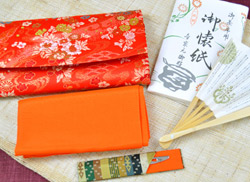
●白扇(はくせん)
ご挨拶の時やお道具を見るときに、自分と対象物の間に置くことよって、境界線が作れるのです。
お正客(しょうきゃく)を任されるなら、必須のアイテムです。
▶お正客って?『はじめてのお茶会講座🔰』を観てね。
はじめてのお茶会では必要ないかもしれませんが、これを持っていると通な感じ!?
先生に謝礼金をお渡しする時などに祝儀袋を乗せて差し出すのなどすると、日本のアイテムを使いこなしている感がかっこよかったりします(笑)。
3.お茶室での、最低限のマナーについて。
・お道具を傷つけるおそれのある指輪や時計、ロングネックレスはあらかじめ外しておきましょう。
・畳のへりを踏まないように歩きます。
・お点前をする畳(道具の置いてある畳)には、入らないようにしましょう。
・お茶碗などお道具を手にとって見せて頂ける時間があることもありますが、そのときは必ず「両手」で持って、「両肘を畳に付けて」。万が一落としてもしまっても、割れないようにしましょう!
3. About the minimum manners in the tea room.
・Remove any rings, watches, or long necklaces that may damage your tools.
・Walk so as not to step on the edge of the tatami mat.
・Please do not enter the tatami mats where the utensils are placed.
・There may be times when you can pick up utensils such as rice bowls and show them to us, but at that time, be sure to hold them with both hands and place your elbows on the tatami mat. Even if you drop it, make sure it doesn’t break!
●服装などに関するマナー・・・まず、お道具を傷つける可能性がある指輪やロングネックレスなどは外しておきましょう。
指輪はお茶碗などを持ったとき、長いネックレスは屈んでお道具を見るときにカチャカチャと当たってしまうかもしれないからです。
同様の理由で、長すぎるネイルチップやストーンなどが沢山付いているネイルアートなども、避けた方がいいでしょう。
またお香が炊いてある場合などもあるので、強すぎる香水なども避けます。

錦鯉爺さん 「お茶は、俗世を離れて無の境地に近付くという側面もあるからの・・・。
なるべく落ち着いた服装を心がけたいものじゃのう。」
<関連記事>お茶は、「無の境地に近づく」修行!?
●茶室でやってはいけないこと・・・お道具畳と呼ばれる、お抹茶を点てる畳に入ることは避けましょう。
畳のへりを踏むこともいけません。畳のへりには、貴重なお道具を置くことがあります。
足の裏で踏むことのないようにしましょう。

●お茶碗などのお道具を、高く持ち上げて見る・・・絶対にNGです(><)
「拝見」の時間にはお道具を手にとって裏側の銘を見たりすることもできますが、必ず「両手で持って」「両方の肘を畳に付けて」
低い位置で見るようにします。
その位置なら、万一手が滑って落としてしまっても割れることはない、という配慮からです。

たまちゃん「両肘を畳に付けた姿勢でお道具を見るのは、結構大変だね~(汗)」

錦鯉じいさん「高く持ち上げて、万が一落としてしまっては大変だからの!
昔は、お茶碗一個でお城と交換できる位貴重だったこともあるのじゃ。」

たまちゃん「ひえ~!」
3.これが出来たらカッコいい!お茶室での立ち居振る舞いについて。
「座り方」「立ち方」「歩き方」「襖の開け方」「締め方」
お茶席での正座とお辞儀の仕方(石州流の場合)
膝は拳ひとつ分ほど開いて座り、両手は卵を持つように軽く握ったまま、両腿の上に置きます。
座り方
片足を少し後ろにひいてから、そちらの足の膝を先について正座します。両膝を揃えて、正座をします。
立ち方
普通の正座の状態から→両足の指を内側に全て反らせて→片足の裏を前に出して片膝を上げ、→(ぐらつかないコツとしては両方の足裏のつま先に、均等に力をかけて)ゆっくりと立ち上がり、前に出ている方の足を少しひいて両足を揃えます。
↑
「座る、立つ」など動作の説明は、文字で書くと複雑に感じますが(^^;
動画をご覧頂い方が、わかりやすいかと思います♪
襖の開け方
正座した状態から、右手を襖の取手にかけて少し(15cm位)だけ開けます。
開いた襖の下方に反対の方の手をかけ、一気に開けます。
襖の締め方
閉めるときは、開けるときと逆の動作をします。
まずは、左手を下方にかけて襖を閉めますが、少しだけ残すようにします。
次に、右手を襖の取手にかけぱたんと最後まで閉めます。
その他のルールやマナー
お菓子やお抹茶を頂くきは、「お先に」と隣の方に言ってからにしましょう。
いかがだったでしょうか?
これらを抑えておけば、きっとお茶会をお気軽に楽しむことができます(^^)
ぜひ、お茶会に参加されてみてくださいね!
さて次回は、金魚亭『はじめてのお茶会講座🔰』です!これさえ読めば、お茶会が30倍楽しくなること請け合いです♪

Leave a Reply